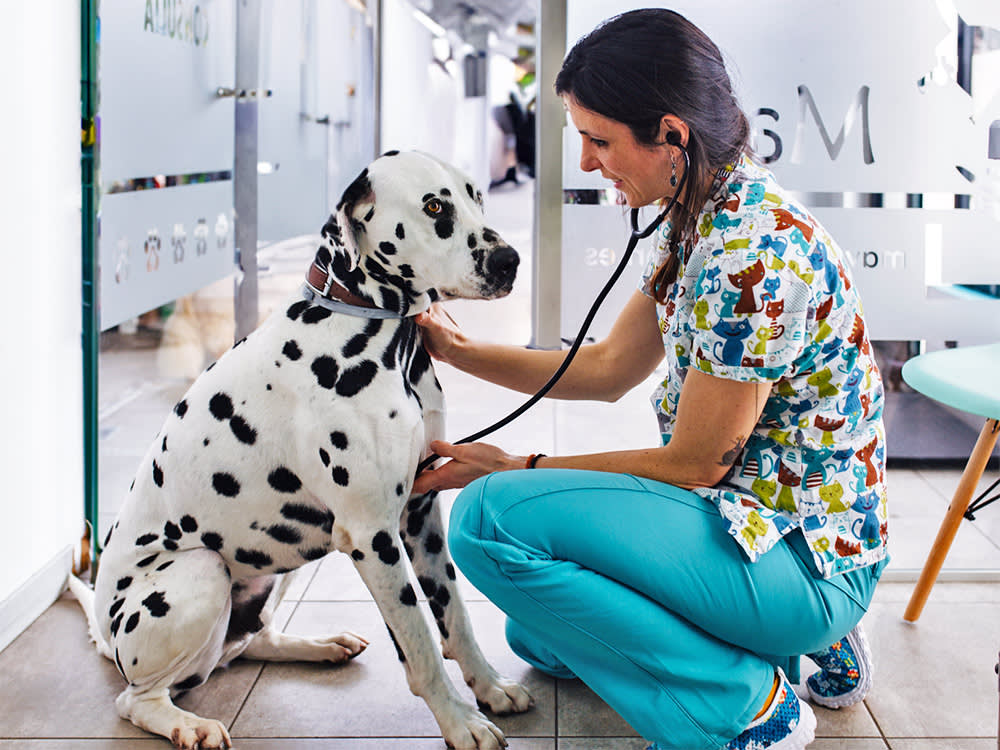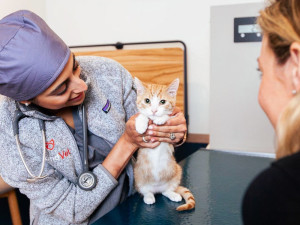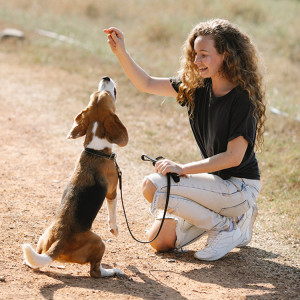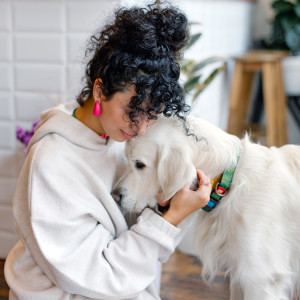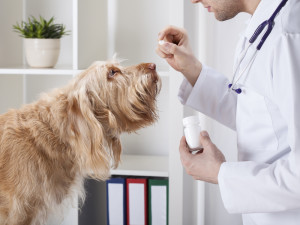Does Your Dog Have Nightmares About the Vet? Try These 8 Tips
Keep calm and get blood drawn.
Not to be dramatic, but a visit to the veterinarian can be the most stressful half hour of your dog’s year. The small rooms, the needles, the prodding hands, the slippery tables. Listen, who wouldn’t get a little antsy under these circumstances?
But because seeing a vet is a non-negotiable over your dog’s lifetime, the best course of action is to set them — and yourself — up for success. The good news is that it’s possible for animals to develop a neutral relationship with the big, bad (wonderful, hard-working) vet. But keeping your dog calm is a team effort. “It’s not only the vet’s job, but it’s the pet parent’s job, too,” says veterinarian Dr. Alex Schechter, founder of Burrwood Veterinaryopens in new tab in Detroit.
Trick question: All dogs are perfect! But find out which type is the best fit for you.
Lucky for us, veterinarians and veterinary behaviorists have thoughts on how to prep your pet for the trip. Below are eight ways to not only keep your pup healthy — but happy, too.
1. Look for that “Fear Free” certification at the vet.
Vets at your local clinic can take a courseopens in new tab and get a Fear Free certification. In short, the course teaches techniques for low-stress handling and anxiety minimization. It prioritizes treats and distraction over forceful manual restraints when vets need to administer shots or draw blood. Knowing that your clinic has this training, or any training based on a philosophy you agree with, can ensure you’re on the same page before you walk through their doors.
How much do you spend on your pet per year?
You, the pet parent, should be as free of fear as possible, too, so make sure you’re working with a practice you generally like. Your dog will follow your cues, and being at ease sets a good example.
“‘Find a vet that’s the right fit for you, so that when you’re there, you’re also relaxed and comfortable because if the pet parent’s anxious and nervous, their pets feed off that a little bit,” Dr. Schechter adds.
2. Introducing “happy visits,” aka going to the vet even when there’s nothing technically wrong.
One of the tenets of Fear Free certification is desensitization. You can desensitize a dog to the vet by dropping in for a visit and a treat with some frequency throughout the year. They’re called “happy visits,” and the point is to build up positive associations with your clinic of choice, so when you go in for your dog’s annual check-up or for an emergency, they don’t automatically begin to pant.
“Most vets are going to be very open to [drop ins] because when pets are very anxious it impacts every part of the visit,” veterinarian Dr. Stephanie Liff, the medical director and owner of Pure Paws Vet Careopens in new tab in New York City, says (her practice is fear-free certified). “Everyone is stressed, the dog has a bad experience, it’s hard to do an exam. Sometimes, it’s impossible to get bloodwork if you need it. So a happy, calm pet at the vet is very good for everyone.”
The visits can take just a couple minutes, and Dr. Liff suggests going as often as your schedule allows, which could mean once a week, once a month, or a few times a year. You arrive, say hello to the front-of-office employees, and give your dog a high-value treat, praise, or do a quick play session.
3. Practice more focused desensitization techniques.
Pair the drop-in visits with the other desensitization techniques that will prep your dog for how they will be handled and inspected at the vet. And — this part’s important — start as soon as possible once your dog comes home with you.
“Don’t even wait until you see your dog is fearful,” says veterinarian Dr. Vanessa Spano, the director of veterinary services at the ASPCA Adoption Center in New York City. “You could work with trainers — ideally, it would be a trainer [who uses] positive reinforcement in theory — and do a protocol of desensitization to handling where you gradually acclimate the pet to very subtle handling at first.”
“If you want to do desensitization correctly, whether it involves vet visits or de-sensitizing to kids, or whatever it is, you always want to set the bar really really low,” Dr. Spano adds.
Shelby Semel, Head of Training and Behavior at Animal Haven Shelteropens in new tab in New York City and founder of Shelby Semel Dog Trainingopens in new tab, suggests paying attention to your dog’s distinct vulnerabilities. If they don’t like to have their ears touched due to too many infections or they never liked to have their paws touched, begin there.
Desensitization can take time. For example, Semel worked with a Havanese who had an issue with people touching his paw. She began teaching him the paw cue, which was like a “low five.” Then, instead of the quick touch and release, she held his paw for a moment longer. From there, Semel worked on touching his paw after he completed the cue.
“It took four and a half months, but now I can touch his dog’s paw, and he doesn’t care,” Semel says.
4. You can B.Y.O.Yoga Mat.
Dogs can feel uncomfortable when picked up and placed on high areas, especially when those areas are metal and slippery. Dr. Spano recommends asking the vet to examine them on the floor. If that’s not possible, bring a yoga mat.
“If we’re on a slippery floor, we lose our balance. That’s really fear-inducing, so it’s important to have traction. I would take out a yoga mat to put on the exam table,” Dr. Spano says.
You can teach them “place” with the yoga mat as well, so they are fulfilling a familiar cue for which they know they’ll be rewarded.
5. Say no to nail trims.
Maybe you’ve worked hard on desensitizing your dog and their paws to clippers. That’s wonderful, but save the payoff for the groomer or your at-home nail clipping. Dr. Schechter doesn’t recommend getting your dog’s grooming done at the vet.
“We want to create as stress-free an environment as possible,” he says. “If we do non-medical things like nail trims, which dogs hate, then when they actually come here as a necessity, they’ll be nervous and uncomfortable.”
6. Try good, old-fashioned anxiety medication.
Know the signs of anxiety in your dog, the ones that you can detect in their body language, like shaking, tail between their legs, ears back, eyes bugging to the point you can see the whites of the eyeball, and licking their lips. If you see that your pet has vet anxiety, share that information when booking an appointment. They can prescribe some medication for the dog and couple the meds with drop-in “happy visits” in the week leading up to the appointment (during which time you give them their most high-value treat).
“We’re very liberal about prescribing anxiety medications for patients that have anxiety, because more bad experiences lead to more bad experiences, so the sooner you can intervene, the better,” Dr. Liff says.
It’s also OK to try again later, this time with meds. “If we see them and they’re too anxious, we’ll have them come back on a different day on prescription medication to help relax them a little bit as opposed to manually restraining them,” Dr. Schechter adds.
7. Consider at-home or telemedicine appointments.
Sometimes, a dog’s stress comes from their own bad experiences at a place, and sometimes it comes from the smell of other dogs’ anxiety in that place. Either way, a home visit from a vet may be a good option for them. It’s a growing mode of service, especially in major metropolitan areas. (On the other hand, and perhaps obviously, this would not be a good option for dogs who are territorial of their homes.)
Another choice in some states is telemedicine. “You need to set up a legal vet-client-patient relationship (VCPR) with a vet that’s pre-existing, but once that’s done, telehealth or telemedicine is really valuable because you’re not bringing your dog to the clinic or an unfamiliar place, you can ask your vet all those questions, tell them the medical history, and then you’ve taken away like 30 minutes of the appointment without the dog being afraid,” Dr. Spano of the ASPCA says.
Telemedicine is not an option in all states, so you’ll need to look into your own state’s lawsopens in new tab; the ASPCA is actively advocating opens in new tab for those laws to be updated.
8. Ace the administration portion of the visit.
“Emailing or making sure you have your vaccine records or medical historyopens in new tab if you’re transferring to a different vet or if you moved again is smart,” Dr. Schechter says. “It just makes it a much smoother process.”
And, as Dr. Spano points out, if you have all this paperwork, plus updated information on your dog’s diet, at the ready, that leaves more time for you to dedicate to low-stress handling, and giving your pup all the time they need to have a relaxed time — or at least a neutral time — at the vet.
